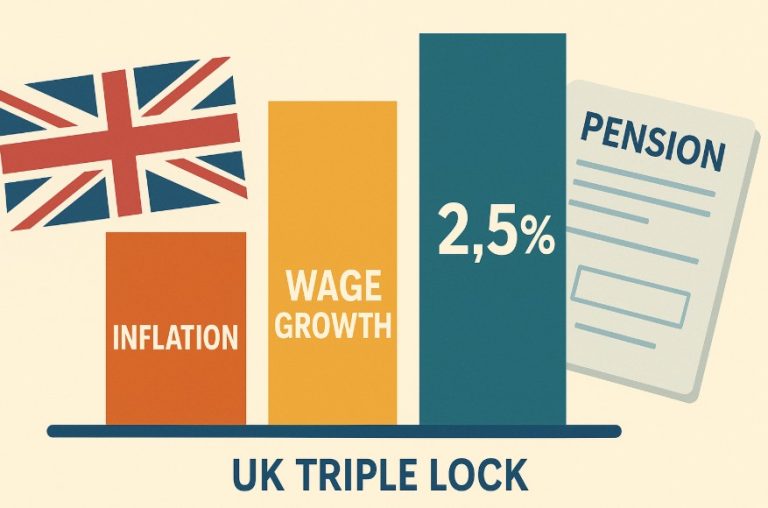The UK state pension system has undergone significant reform in recent years, most notably with the introduction of the new State Pension in April 2016.
Many people reaching retirement age often find themselves comparing the older and newer systems and wondering why the old State Pension is less than the new one.
This article breaks down the reasons behind the difference, exploring how entitlements are calculated, what changed in 2016, and what it means for pensioners today.
What Is The Difference Between The Old And New State Pension Systems?

The UK State Pension underwent a major overhaul on 6 April 2016, resulting in two separate systems: the old State Pension and the new State Pension.
The key difference lies not just in the amount paid to individuals, but also in how the pension is calculated, the number of qualifying years required, and how employment history and contributions affect entitlements.
The system you fall under depends on when you reached State Pension age:
- If you reached State Pension age before 6 April 2016, the old system applies to you.
- If you reach State Pension age on or after 6 April 2016, you’re covered by the new system.
Here’s a detailed look at the main differences:
Structure Of Payments
Old State Pension:
- Comprised of two components:
- Basic State Pension – a flat rate based on qualifying National Insurance (NI) years.
- Additional State Pension – based on earnings and contributions to government-run schemes like SERPS and S2P.
- Many individuals also received top-ups or deductions depending on whether they were contracted out or had gaps in employment.
- Complex and varied widely from person to person depending on earnings and career history.
New State Pension:
- A single-tier flat-rate payment.
- Simpler and easier to forecast.
- No additional State Pension or earnings-related top-ups.
- Designed to treat different types of workers more fairly, including the self-employed.
Qualifying Years Requirement
- Old system: 30 qualifying years of National Insurance were required for a full basic State Pension.
- New system: 35 qualifying years are needed to receive the full new State Pension amount.
- Anyone with fewer than 10 years may not qualify for any pension under the new rules.
However, if you have fewer than 35 years, your pension is calculated proportionally. For example, with 28 years, you would receive 28/35 of the full new pension.
Full Weekly Amount
There is also a noticeable difference in the maximum weekly amount payable:
| Pension System | Full Weekly Amount (2025/26) |
| Old State Pension | £176.45 (basic) + additional amount based on earnings |
| New State Pension | £230.25 (flat rate, can be higher with protected payment) |
Note: The old State Pension could end up being higher or lower than the new State Pension depending on whether the individual qualified for a substantial additional pension through SERPS or S2P.
Complexity And Transparency
The old system was known for its complexity. It involved multiple calculations and was affected by factors such as:
- Contracted-out periods
- Changes to the State Second Pension
- Earnings thresholds
- Supplementary top-ups and credits
In contrast, the new system is structured to be:
- Easier to understand
- Predictable for retirement planning
- Fairer across all employment types, especially those without access to occupational pensions
Impact On Different Groups
- Self-employed workers: Under the old system, they could not accrue additional State Pension. The new system puts them on equal footing with employed workers.
- High earners: Benefited more under the old system due to the earnings-linked additional pension.
- Low earners and those with interrupted careers: Often benefit more from the new system because it provides a clearer path to a decent retirement income.
How Did National Insurance Contributions Impact The State Pension?

National Insurance contributions play a central role in calculating State Pension entitlement. The old and new systems both rely on NI records, but the way those records are assessed varies significantly.
In the old system, an individual needed 30 qualifying years of NI contributions to receive the full basic State Pension. The additional pension was built up based on earnings and how long the person contributed to SERPS or S2P. This resulted in a wide range of pension outcomes.
In the new system, individuals require 35 qualifying years to receive the full State Pension. If they have fewer qualifying years, the amount is reduced accordingly. The new system does not offer an additional pension, so the final payment is simpler to calculate but can still be affected by contracted-out periods.
To qualify for a full pension:
- You must have at least 35 years of NI contributions or credits if your record began after April 2016
- Individuals with fewer than 10 years may not qualify for any pension
- Gaps in your NI record can be filled by making voluntary contributions
These requirements have created differences in entitlements, especially for individuals who were partially contracted out or who had career breaks.
Why Were People ‘Contracted Out’ And How Did It Affect Their Pension?
Contracting out was a feature of the old system that allowed workers to divert part of their NI contributions into a workplace or private pension scheme. In doing so, both the employee and employer paid lower NI rates. However, this reduced the entitlement to the additional State Pension.
Contracting out applied primarily to:
- Employees enrolled in defined benefit (final salary) or occupational pension schemes
- Public sector workers with alternative pension arrangements
As a result of being contracted out, these individuals built up less entitlement under SERPS or S2P. When the new State Pension was introduced, these reduced contributions were factored in as deductions, resulting in a lower pension amount unless topped up by transitional protections.
The effect of contracting out can still be seen in the pensions of those reaching retirement today. Even individuals with more than 35 qualifying years may receive less than the full new State Pension if part of their employment history involved contracted-out periods.
What Role Did Additional And Earnings-Related Pensions Play In The Old System?

The old State Pension system, which applied to those who reached pension age before 6 April 2016, was composed of more than just a flat-rate payment.
In addition to the basic State Pension, eligible individuals could receive an earnings-related top-up, commonly referred to as the Additional State Pension.
This additional element played a crucial role in determining the total amount of State Pension an individual received under the old system. It was designed to reward higher earners and those with continuous employment histories by providing extra pension income based on their earnings and National Insurance contributions over time.
There were two key earnings-related schemes that made up the Additional State Pension:
The State Earnings-Related Pension Scheme (SERPS)
SERPS, short for the State Earnings-Related Pension Scheme, was introduced in 1978. It allowed individuals to accrue a higher pension amount in retirement based on their annual earnings that exceeded the Lower Earnings Limit (LEL) set by the government.
Key characteristics of SERPS included:
- Operated between 1978 and 2002
- Offered higher earners the opportunity to build a larger State Pension
- Based the additional amount on a percentage of earnings above the LEL
- Required consistent and long-term contributions to maximise benefits
Those who earned more and paid higher levels of National Insurance contributions built up substantial additional entitlements under SERPS. As a result, many pensioners receiving their pension under the old system today benefit from higher overall amounts than the flat-rate seen in the new system.
The State Second Pension (S2P)
The State Second Pension (S2P) replaced SERPS in 2002, with the goal of making the system more inclusive and beneficial to low and moderate earners.
While SERPS favoured higher earners, S2P was designed to redistribute benefits and increase the retirement income of people who may not have been well-served by the previous scheme.
Key features of S2P included:
- Greater benefit accrual for low-income earners
- Recognition of carers, disabled individuals, and those with long-term illness
- Still based on earnings, but with a more generous formula for those on modest incomes
- Provided automatic credits for qualifying groups even without direct contributions
S2P broadened access to the Additional State Pension, allowing more people to accumulate additional entitlements even if they were not in full-time employment or earning high wages.
How These Schemes Influenced Total Pension Income?
The Additional State Pension, whether from SERPS or S2P, significantly increased the retirement income for many individuals.
This meant that the total pension a person received under the old system was highly variable and could differ dramatically based on their earnings history, employment type, and contribution record.
Factors that influenced the final amount included:
- Years of contributions into SERPS or S2P
- Earnings level throughout one’s working life
- Whether the person had contracted out of the additional pension (e.g. through a workplace or private pension scheme)
Those with high and continuous earnings often received a substantial top-up, pushing their weekly pension income well above the basic State Pension amount.
For example, someone with 30 years of high earnings under SERPS could receive double the basic amount or more in some cases.
Contracting Out And Its Impact
While the Additional State Pension had clear benefits, not everyone participated in it. Many individuals, particularly those in public sector jobs or occupational pension schemes, were contracted out.
This meant they and their employers paid lower National Insurance contributions in exchange for reduced entitlement to SERPS or S2P.
The idea behind contracting out was that these workers would be receiving equivalent or better retirement benefits from their private or workplace pension schemes.
However, this also resulted in a lower Additional State Pension, and therefore, a reduced total pension under the old system.
In many cases, the impact of contracting out can still be seen in today’s pension payments. Even if someone qualified for the full basic State Pension, their overall income could be reduced due to the lack of additional pension benefits.
Why The Additional State Pension Was Phased Out?
The earnings-related element of the old State Pension system introduced complexity and inequality. While it rewarded consistent high earners, it often left self-employed people, low-income workers, and those with gaps in employment with less support in retirement.
Some of the main criticisms included:
- Complexity: The calculation methods for SERPS and S2P were difficult to understand
- Unfairness: Those outside of full-time, continuous employment often received less, even with long working lives
- Inequality: High earners benefited the most, creating a disparity in pension outcomes
For these reasons, the government opted to remove the Additional State Pension as part of the 2016 reforms, replacing it with the new State Pension a simpler, flat-rate structure intended to be easier to understand and fairer across all employment types.
However, transitional measures were put in place to ensure that individuals who had already built up SERPS or S2P entitlements before 2016 would not lose out. These entitlements were either carried over or protected in the form of a protected payment.
Comparison Table: SERPS vs S2P
| Feature | SERPS | State Second Pension (S2P) |
| Operated From | 1978 – 2002 | 2002 – 2016 |
| Target Group | High earners | Low to moderate earners |
| Contribution Requirement | Based on earnings above the Lower Earnings Limit | Based on a broader formula with credits |
| Inclusiveness | Limited | More inclusive (carers, disabled, low-income) |
| Benefit Formula | Proportional to earnings | Weighted towards lower earners |
Why Was The State Pension System Reformed In 2016?
The decision to reform the State Pension system was driven by several issues in the previous model. The old system, although comprehensive, had become increasingly complex over time.
Many individuals found it difficult to understand how much pension they would receive or what they needed to do to increase their entitlement.
The reform sought to:
- Eliminate the confusion created by multiple components such as SERPS and S2P
- Provide a clear and predictable income in retirement
- Align pension entitlements more fairly across different employment sectors, including the self-employed
Another goal of the reform was to ensure the long-term sustainability of the State Pension system, especially in the context of an ageing population and longer life expectancy.
The new system, although more straightforward, introduced transitional rules. These rules ensure that those who had contributed under the old system did not lose their entitlements. However, this also means that for several years, pensioners will receive different amounts even if they have similar work histories.
Who Benefits More From The New State Pension And Why?

The new State Pension model has been particularly beneficial for groups that were disadvantaged under the old system. These include:
- Low and middle-income earners, who may not have accumulated a substantial additional pension under SERPS or S2P
- Self-employed workers, who were excluded from additional pension schemes
- Individuals with inconsistent employment records, including carers or those who had long periods of part-time work
These groups often had lower total entitlements under the old system but now have the opportunity to receive a higher flat-rate pension, provided they meet the NI contribution requirements.
In contrast, high earners who consistently paid into SERPS or S2P under the old system may find that their new State Pension is lower than what they would have received.
To protect these individuals, the government introduced protected payments, which ensure that no one is financially disadvantaged by the change.
How Is The State Pension Calculated Under The New System?
The calculation of the new State Pension is based on a straightforward formula that takes into account:
- Your total number of qualifying years
- Whether you have any contracted-out periods from before 2016
- Whether you are eligible for a protected payment
Each qualifying year contributes approximately 1/35th of the full State Pension amount, which in 2025/26 is £230.25 per week. For example:
| Qualifying Years | Weekly Pension (Approximate) |
| 35 | £230.25 |
| 30 | £197.36 |
| 20 | £131.57 |
| 10 | £65.79 |
If you were contracted out, your starting amount may be reduced to reflect the lower NI contributions during those years. However, if your pre-2016 entitlements exceed the full new pension amount, the protected payment is added to the standard weekly rate.
This protected payment is also indexed, increasing annually in line with the Consumer Prices Index (CPI), unlike the rest of the new State Pension, which is increased by the triple lock (whichever is highest of earnings growth, CPI, or 2.5%).
What Are The Common Misconceptions About The Old Vs New State Pension?

There are several common misunderstandings surrounding the differences between the two pension systems. Clarifying these misconceptions is essential for effective retirement planning.
- Some people believe that everyone receives the same amount under the new system, but this is only true if you have a full 35-year record without contracted-out periods.
- There is a notion that individuals with 35 years of contributions will automatically get the full new State Pension, which is not always the case if deductions apply.
- Many assume that it’s too late to increase their pension, but options like voluntary NI contributions still exist.
- Another misconception is that the old system was worse for everyone, yet high earners often received more through SERPS and S2P than they would under the flat-rate model.
Understanding the factors that influence your specific situation is vital, including employment history, NI record, and whether you were contracted out.
Conclusion
The old State Pension is generally less than the new State Pension because it was structured differently, with a flat base and variable additional elements. The 2016 reform aimed to create a fairer, simpler system, resulting in a higher flat-rate payment.
However, due to contracting out, incomplete NI records, and transitional rules, not everyone receives the full new amount. It’s important for individuals to review their NI records, understand their entitlements, and take steps to maximise their retirement income if possible.
Frequently Asked Questions
Can I increase my old State Pension amount?
Yes. You may be able to increase it by paying voluntary NI contributions, using your partner’s NI record, or deferring your pension.
How do I know if I was contracted out?
You can check this by reviewing your National Insurance statement through the government website. It will show contracted-out periods.
What is a protected payment under the new State Pension?
A protected payment is an amount added on top of the new State Pension if you would have received more under the old system.
Is it possible to get both the old and new State Pension?
No. Your pension entitlement depends on when you reach pension age. You’ll either be under the old or the new system, not both.
Why do some people get more than the full new State Pension?
Because they built up a large additional State Pension before 2016. The protected payment reflects that.
Can I still get a pension if I don’t have enough NI years?
Yes, but it will be a reduced amount. You may also qualify for Pension Credit depending on your circumstances.
What happens if I defer my State Pension?
If you defer, your payments will be higher when you eventually claim. It’s a way to boost your income later in retirement.






